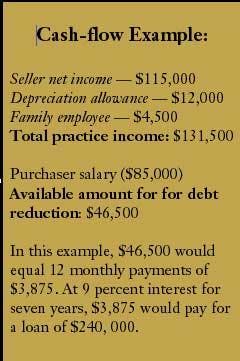As easy as one, two, three
Dr. Michael Gradeless
When I was in college, I sang with a polka band for extra money. We played weekly gigs at such notable venues as the American Legion and the Fraternal Order of Police, but the jobs that were the most fun were the big Polish-Catholic weddings where everybody danced the polka.
Now, the polka is one of the easiest dances to learn because it is a simple three count. If you learned how to skip in kindergarten, you can dance the polka. Buying a dental practice is also a simple, three-step dance. Emotion and fear may cloud your judgment, but there are really only three important points to consider.
Location: As with any piece of real estate, the most important factor is location. It doesn't matter how much money you could make or how great a deal someone offers you — where you want to live and practice is non-negotiable. If you know exactly where you want to live and practice and there are no existing opportunities there, make your own opportunity by starting your practice from scratch.
Cash flow. When you buy a dental practice, what you are purchasing is cash flow. There are many ways to value a dental practice, but the only one that matters is whether the inherent value will pay the debt service and return the income you require. You will need to perform an in-depth analysis of the practice cash flow numbers, but you can also do a quick calculation to determine if a practice is priced fairly. Start with the selling doctor's net income as reported on the federal tax return and add back deductions that create extra cash. Then subtract the amount of salary you would expect for the first year. Divide the remainder by 12 to determine the amount that should be available for monthly debt payments. The total amount of debt that this monthly payment will service is the maximum price that should be paid for that practice.
When analyzing the cash flow, it is important to realize that debt service is an absolute fixed cost. The doctor's salary also should be considered a fixed cost; all too often, it is treated as a variable.
Gross production retention: The ease with which you duplicate the selling doctor's success depends on the quality of the systems in the practice. If the systems are well developed and the staff is motivated and trained to operate the systems, the office will continue to produce seamlessly. The four main systems in a dental practice are appointment scheduling, financial arrangements and collections, new-patient examinations, and continuing care. These systems will have the most value if they are actually standardized in writing. In most practices, the systems are not written but have been handed down from employee to employee by word of mouth. Systems that are handled in this way are very vulnerable to change and can even be totally lost whenever there is staff turnover.
If you are looking to transition to practice ownership, use these three steps to evaluate your options. Checking out the available practices will be great fun. Next month, I'll give you some questions to ask that will help you uncover the operational systems in your future practice.
Dr. Michael Gradeless, a 1980 graduate of Indiana University, practices preventive dentistry in Indianapolis with an emphasis on cosmetics and implants. He is an adjunct faculty member at Indiana University where he teaches the Pride Institute university curriculum of dental management. He is also the editor for the Indiana Dental Association. Contact him at (317) 841-3130 or email: [email protected].

